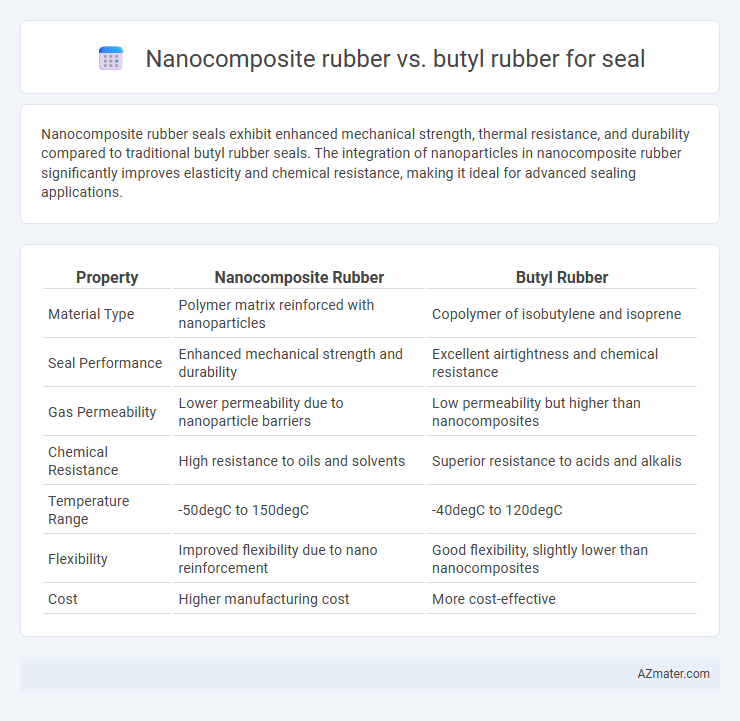Nanocomposite rubber seals exhibit enhanced mechanical strength, thermal resistance, and durability compared to traditional butyl rubber seals. The integration of nanoparticles in nanocomposite rubber significantly improves elasticity and chemical resistance, making it ideal for advanced sealing applications.
Table of Comparison
| Property | Nanocomposite Rubber | Butyl Rubber |
|---|---|---|
| Material Type | Polymer matrix reinforced with nanoparticles | Copolymer of isobutylene and isoprene |
| Seal Performance | Enhanced mechanical strength and durability | Excellent airtightness and chemical resistance |
| Gas Permeability | Lower permeability due to nanoparticle barriers | Low permeability but higher than nanocomposites |
| Chemical Resistance | High resistance to oils and solvents | Superior resistance to acids and alkalis |
| Temperature Range | -50degC to 150degC | -40degC to 120degC |
| Flexibility | Improved flexibility due to nano reinforcement | Good flexibility, slightly lower than nanocomposites |
| Cost | Higher manufacturing cost | More cost-effective |
Introduction to Seal Materials: Nanocomposite vs Butyl Rubber
Nanocomposite rubber incorporates nanoscale fillers to enhance mechanical properties, chemical resistance, and thermal stability, making it highly suitable for advanced sealing applications. Butyl rubber, known for its excellent impermeability and good flexibility, provides reliable sealing against gases and moisture in diverse industrial uses. The comparison highlights nanocomposite rubber's superior durability and performance in extreme environments versus butyl rubber's cost-effectiveness and proven sealing efficiency.
Chemical Composition and Structure Comparison
Nanocomposite rubber incorporates nanoscale fillers such as clay, carbon nanotubes, or silica within a polymer matrix to enhance mechanical strength, chemical resistance, and thermal stability, resulting in a complex multi-phase structure with improved barrier properties. Butyl rubber, a copolymer of isobutylene and isoprene, features a saturated polyisobutylene backbone with isolated unsaturation from isoprene units, giving it excellent impermeability to gases and exceptional chemical inertness. The nanocomposite structure provides superior reinforcement through strong filler-polymer interactions, while butyl rubber's inherent low permeability stems from its dense, amorphous molecular network and limited unsaturation, making each material suitable for different sealing applications based on performance demands.
Mechanical Strength and Durability
Nanocomposite rubber exhibits superior mechanical strength compared to butyl rubber due to the incorporation of nanoscale fillers like carbon nanotubes or clay, which enhance tensile strength and abrasion resistance. Butyl rubber, while offering excellent air impermeability and chemical resistance, typically shows lower tensile strength and is more prone to degradation under mechanical stress. Nanocomposite formulations provide enhanced durability and long-term performance in seals, making them suitable for demanding applications requiring high mechanical robustness.
Elasticity and Flexibility Performance
Nanocomposite rubber exhibits superior elasticity and enhanced flexibility compared to butyl rubber, thanks to the integration of nanoscale fillers that improve polymer chain mobility and resilience. Butyl rubber offers excellent impermeability and chemical resistance but tends to have lower tensile strength and elasticity under dynamic stresses. The incorporation of nanoparticles in nanocomposite rubber significantly boosts elongation at break and recovery rates, making it ideal for seals requiring high durability and flexible deformation.
Gas and Moisture Permeability Analysis
Nanocomposite rubber exhibits significantly lower gas and moisture permeability than butyl rubber due to its enhanced molecular barrier properties achieved by uniformly dispersed nanofillers such as graphene or clay. The tortuous path created by these nanofillers effectively reduces the diffusion rate of gases like oxygen and moisture vapor through the polymer matrix, improving sealing performance. Comparative studies demonstrate nanocomposite rubber with permeability coefficients up to 50% lower than conventional butyl rubber, making it superior for applications requiring stringent gas and moisture resistance.
Thermal Stability and Aging Resistance
Nanocomposite rubber exhibits superior thermal stability due to the inclusion of nanoparticles such as silica or clay, which enhance heat resistance and reduce degradation at elevated temperatures. Butyl rubber offers excellent aging resistance through its low permeability to gases and chemicals, maintaining flexibility and sealing performance over extended periods. For seals subjected to harsh thermal environments, nanocomposite rubber outperforms butyl rubber by sustaining mechanical integrity and preventing thermal breakdown more effectively.
Chemical and Environmental Resistance
Nanocomposite rubber exhibits superior chemical resistance compared to butyl rubber, effectively withstanding aggressive solvents, oils, and acidic environments due to its enhanced filler dispersion and polymer matrix reinforcement. Butyl rubber is known for excellent resistance to polar substances and excellent impermeability to gases but shows lower performance against hydrocarbons and solvents. Environmental resistance of nanocomposite rubber extends to improved UV stability and ozone resistance, surpassing butyl rubber's moderate resistance under prolonged exposure to harsh weather conditions.
Processing and Manufacturing Considerations
Nanocomposite rubber offers enhanced mechanical strength and barrier properties due to the uniform dispersion of nanoparticles, requiring precise mixing techniques like high-shear or ultrasonic dispersion during processing. Butyl rubber, known for its excellent impermeability and flexibility, is easier to process using conventional mixing and extrusion methods but may require longer curing times. Manufacturing considerations favor nanocomposite rubber for high-performance seals demanding improved durability, while butyl rubber provides cost-effective and scalable production for general sealing applications.
Cost-Effectiveness and Market Availability
Nanocomposite rubber offers enhanced mechanical properties and durability, often at a higher initial cost compared to traditional butyl rubber, which remains more affordable and widely available in the seal market. Butyl rubber dominates due to its excellent impermeability and cost-effectiveness for general sealing applications, while nanocomposite rubber targets high-performance seals in specialized industries. Market availability favors butyl rubber with extensive production and supply chains, whereas nanocomposite rubber is emerging in niche segments, impacting its overall cost-efficiency and accessibility.
Application Suitability and Future Trends
Nanocomposite rubber exhibits superior mechanical strength, enhanced gas barrier properties, and improved thermal stability compared to traditional butyl rubber, making it highly suitable for advanced sealing applications in automotive and aerospace industries. Butyl rubber remains preferred for applications requiring excellent impermeability to gases and resistance to chemical corrosion, such as inner tubes and pharmaceutical stoppers. Emerging trends indicate nanocomposite rubber will dominate future seal technologies due to its customizable properties and potential for integration with smart sensing capabilities.

Infographic: Nanocomposite rubber vs Butyl rubber for Seal
 azmater.com
azmater.com